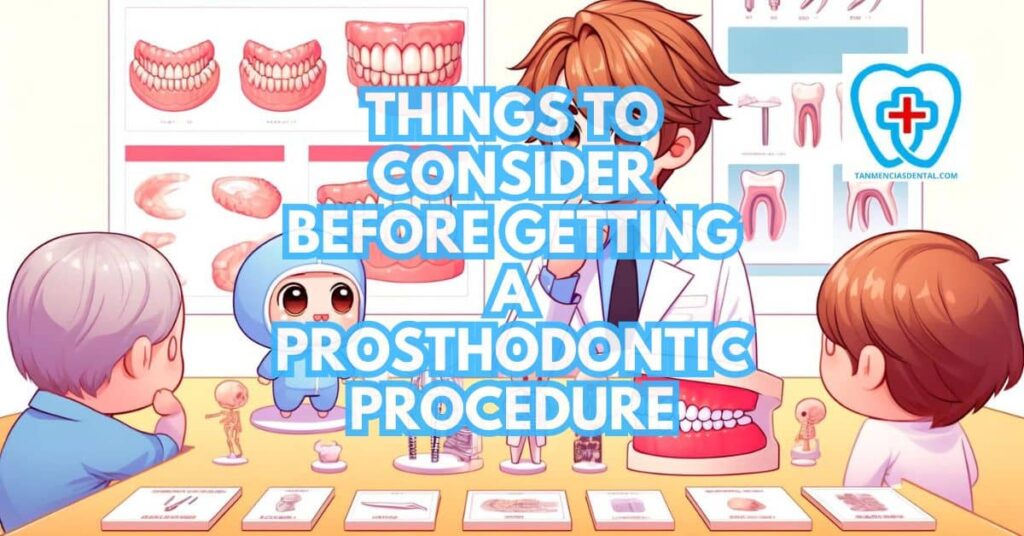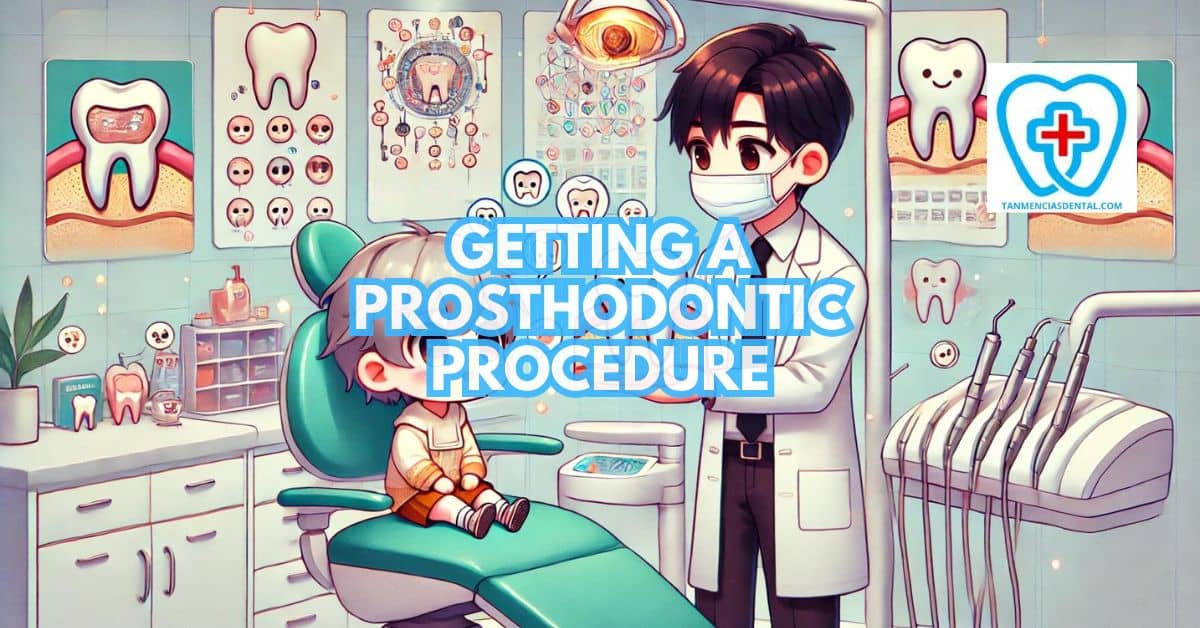Are you thinking about getting a prosthodontic procedure but feeling unsure about where to start?
Many people focus on restoring their smile, but it’s equally important to think about how the procedure will affect your overall oral health.
A prosthodontic procedure involves more than just replacing missing or damaged teeth—it impacts the way your teeth function and fit together.
Making the right choice requires understanding the options and working with a qualified specialist.
We’ll cover key things to consider before moving forward with a prosthodontic procedure to ensure the best outcome for your dental health.
1. Choosing the Right Prosthodontist: Key Qualifications to Ensure Success
Selecting a qualified and experienced prosthodontist is essential for achieving optimal results in your dental restoration.
First, verify that the prosthodontist holds the necessary credentials and certifications from recognized dental institutions, indicating specialized training in prosthodontics.
Second, consider the practitioner’s level of experience and specialization in specific prosthodontic procedures, as this expertise can significantly impact the quality of your treatment.
Third, prepare a list of questions for your consultation, such as asking about their success rates, the technologies they use, and how they handle potential complications.
Plus, reviewing patient testimonials and viewing before-and-after photos can provide valuable insights into the prosthodontist’s skill and patient satisfaction.
Finally, ensure that you feel comfortable and confident in your prosthodontist’s abilities, as a strong patient-practitioner relationship is vital for a smooth and successful treatment journey.
🦷 Unlocking the Mystery of Black Plaque on Teeth: Causes and Essential Prevention Tips
2. The Role of Cosmetic Dentistry in Prosthodontics
In prosthodontics, cosmetic dentistry plays a pivotal role, not just by enhancing the visual appeal of teeth, bites, and gums but also by working in harmony with restorative procedures to ensure optimal functionality and aesthetics.
This branch of dentistry encompasses a wide range of treatments designed to improve the color, position, shape, size, and alignment of teeth, ultimately contributing to a more attractive and harmonious smile.
Among these, dental crowns stand out as a popular option for restoring damaged teeth to their original glory, effectively blending the art of cosmetic enhancement with the science of dental restoration.
Similarly, for those missing several teeth, a set of prosthetic teeth can be a game-changer, not only restoring the ability to chew and speak comfortably but also reviving the person’s confidence in their smile.
Dental fillings, though primarily functional, are crafted with aesthetics in mind, ensuring that they blend seamlessly with the natural tooth structure.
By integrating techniques such as veneers, bonding, and whitening with these restorative procedures, cosmetic dentistry aims to achieve a balance between beauty and function.
This comprehensive approach guarantees that patients not only regain their essential oral functions but also take pride in a smile that looks as good as it feels.
🦷 Why Regular Dental Cleanings Are Key: Discover the Hidden Benefits
3. Deciding Between Crowns and Bridges for Damaged Teeth
When teeth are missing or damaged, crowns and bridges are two of the most reliable solutions available.
A crown is a cap that covers a damaged tooth entirely, helping to strengthen it and restore its shape and function.
It’s often recommended when a tooth is still intact but weakened due to decay or injury.
In contrast, a bridge is used when one or more teeth are completely missing, filling the gap by anchoring a false tooth to the adjacent healthy teeth.
The decision between a crown and a bridge depends on how many teeth are involved and the condition of the surrounding teeth and gums.
Prosthodontists, with advanced training beyond dental school, carefully assess each patient’s unique needs before recommending the best option.
Both procedures require precise preparation and design to ensure a comfortable fit and natural appearance.
🦷 Cracking the Code: Understanding the Causes Behind a Broken Tooth Crown
4. The Benefits of Dental Implants for Missing Teeth
Dental implants stand as a favored option for those looking to replace missing teeth, delivering a solution that is both durable and stable over time.
The process involves the surgical insertion of a titanium post directly into the jawbone, which then serves as a sturdy anchor for an artificial tooth, effectively mimicking the root of a natural tooth.
As the implant bonds with the bone, it forms a strong foundation that can support a dental crown, bridge, or denture, making it versatile enough to restore a single tooth or multiple teeth.
This integration not only ensures the implant remains securely in place but also helps maintain the health of the jawbone by preventing the atrophy typically seen with tooth loss.
Furthermore, dental implants offer the look and feel of natural teeth, enhancing one’s ability to eat, speak, and smile with confidence and without the fear of the prosthesis slipping.
For individuals experiencing issues with their TMJ (temporomandibular joint), implants can contribute to a more balanced bite, potentially alleviating related discomfort.
Also, unlike a root canal, which aims to save a damaged or infected tooth, dental implants provide a new, synthetic option that is impervious to decay, offering a long-term solution for missing teeth.
🦷 Surprising Connections: Can Tooth Decay Really Cause Acne?

5. Opting for Partial or Full Dentures
Dentures offer a removable solution for replacing missing teeth and are available in two main types: partial and full.
Partial dentures are used when some natural teeth remain, fitting snugly over the gaps and often anchored to existing teeth with clasps.
Full dentures, on the other hand, are used when all the teeth are missing in the upper or lower jaw, resting on the gums where the teeth once were.
Both types require precise measurements and customization to ensure a comfortable and secure fit.
Opting for dentures involves considering the extent of tooth loss, the health of remaining teeth if any, and personal comfort with removable dental appliances.
🦷 Brushing Toddler Teeth: Common Mistakes and How to Avoid Them
6. The Importance of Periodontal Health Before Procedures
The foundation of successful prosthodontic treatments, which includes a range of common prosthodontic procedures from dental implants to full mouth reconstructions, rests significantly on the health of periodontal tissues—the gums and the bone beneath them.
Periodontal disease manifests as swollen, tender gums that may bleed during brushing or flossing, along with the deterioration of the jawbone, which can undermine the stability and effectiveness of dental restorations.
Before embarking on any prosthodontic procedure, it’s crucial for dental professionals to conduct a comprehensive evaluation of the patient’s periodontal health to ensure the tissues are capable of supporting the restoration.
In cases where periodontal disease is present, preemptive treatment may be necessary to address these issues before, or alongside, the planned prosthodontic work, ensuring the long-term durability and success of the procedure.
Effective oral hygiene practices are paramount in preventing periodontal disease and, by extension, in preserving the integrity of prosthodontic restorations.
Addressing periodontal concerns promptly can significantly mitigate the impact of complex dental conditions on the outcome of prosthodontic treatments.
Maintaining optimal periodontal health is not just about preserving natural teeth but is also essential in laying a strong and healthy foundation for any prosthodontic procedure, thereby enhancing the overall efficacy and longevity of the treatment.
🦷 Revitalize Your Smile: Explore the Amazing Benefits of Tooth Restoration
7. Consultation with a General Dentist vs. Prosthodontist
While general dentists are skilled in providing comprehensive oral care, prosthodontists specialize in the restoration and replacement of teeth, making them experts in prosthodontic procedures.
A consultation with a general dentist is a good starting point for any dental concern, as they can assess the overall health of your mouth and recommend specialized care if needed.
However, for advanced restoration needs, such as complex bridges, dentures, or implants, seeing a prosthodontist might be advised.
Prosthodontists receive years of additional training in these areas, equipping them with the expertise to handle challenging cases.
The decision to consult a prosthodontist directly often depends on the complexity of the dental issue and the desired outcome.
🦷 The Unsung Heroes: Why Dental Care Professionals Are Essential for Your Oral Health
8. Evaluating the Costs and Insurance Coverage
Prosthodontic procedures can vary widely in cost, depending on the complexity and materials used.
It’s crucial to get a detailed estimate of the procedure’s costs early in the planning process to avoid surprises.
Many dental insurance plans offer partial coverage for prosthodontic procedures, but limits and exclusions can significantly affect out-of-pocket expenses.
Discussing payment and financing options with the dental office can help manage the costs.
Additionally, comparing the long-term benefits and durability of the proposed treatment against the initial investment is essential for making an informed decision.
🦷 Essential Tips for Meeting Your Dental Needs: Achieve Optimal Oral Health
9. Preparing for the Procedure: What to Expect
Preparation for a prosthodontic procedure often involves several visits to the dentist for assessments, measurements, and planning.
Patients should expect detailed discussions about the desired outcomes, possible risks, and steps of the procedure.
Pre-procedure instructions may include adjustments to medication, dietary guidelines, or oral hygiene practices.
For surgical procedures like implants, discussing anesthesia options and arranging for post-surgery transportation are essential.
Understanding the entire process helps patients feel more comfortable and can lead to a smoother procedure and recovery.
🦷 Everything You Should Know About Broken Tooth Repair Kits: Are They Worth It?
10. The Recovery Process and Aftercare
The recovery time and aftercare requirements vary depending on the complexity of the prosthodontic procedure.
Common post-procedure advice includes managing pain with prescribed or over-the-counter pain relievers, adhering to a soft food diet, and avoiding strenuous activity for a short period of time.
Proper oral hygiene, including gentle brushing and, if applicable, cleaning around new restorations, is critical to prevent infection and ensure healing.
Follow-up visits allow the dentist to monitor healing and make any necessary adjustments to the restoration.
Adhering to the dentist’s aftercare recommendations is key to a successful recovery and the long-term success of the procedure.
🦷 Can Saltwater Rinse Really Heal Gum Infections? What You Need to Know Before You Try
11. Long-Term Maintenance of Prosthodontic Restorations
Maintaining prosthodontic restorations is crucial for their longevity and involves regular dental checkups and cleanings, along with good oral hygiene practices at home.
Even though restorations like crowns, bridges, and implants are made from materials that resist decay, the surrounding natural teeth and gums can still be susceptible to disease.
Avoiding hard and sticky foods can prevent damage to restorations.
For denture wearers, proper cleaning and nightly removal are essential to maintaining oral health and the condition of the dentures.
Regular visits to the dentist for inspections can help identify and address any issues before they require significant repairs or replacements.
🦷 The Hidden Dangers of Poor Oral Hygiene: How Neglecting Your Teeth Can Lead to Serious Health Issues
👨⚕️ Conclusion
Getting a prosthodontic procedure is a significant step towards improving your oral health and the appearance of your smile.
With careful planning, understanding the process, and adhering to aftercare and maintenance advice, patients can enjoy the benefits of their new restorations for many years.
Embracing your new smile involves not just the physical transformation but also recognizing the positive impact on your confidence and quality of life.
Remember, the journey to a better smile requires patience, commitment, and collaboration with your dental team.
As you adjust to your new smile, allow yourself to enjoy the renewed confidence and functionality that come with it.
😁 Self-Promotion
At Tan-Mencias Dental Clinic, nestled in the heart of Parang, Marikina City, we’re dedicated to providing you with exceptional dental care in a comfortable and welcoming environment.
Whether you’re seeking a routine checkup or more specialized prosthodontic treatments, our expert team is here to ensure your visit is a pleasant and rewarding experience.
For any questions or to schedule your next visit, feel free to call us at 9171451074, drop us a message through our Facebook page, or reach out via the contact form on our website.
We’re committed to helping you achieve the smile you’ve always dreamed of in a friendly and caring setting.
Join our family at Tan-Mencias Dental Clinic, where your oral health is our top priority, and discover the difference we can make in your smile and confidence today!

